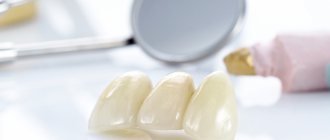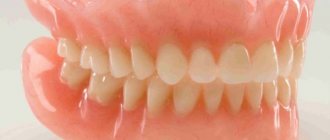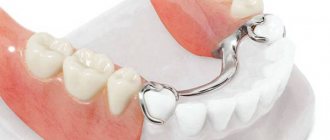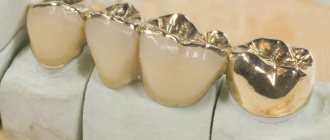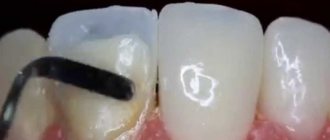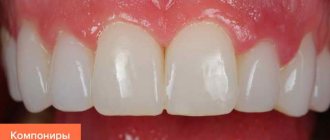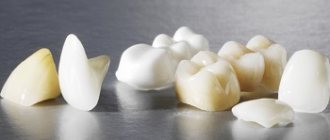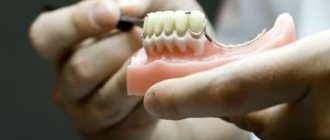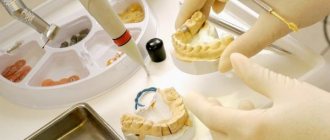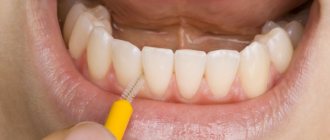Stages of making veneers
Before making permanent structures, they organize the preparation of the elements of the dentition, then make an impression of the patient’s teeth, select the tone of the crown and fix the temporary veneer.
Tooth preparation
To ensure a harmonious appearance of the tooth with veneer, it is necessary to remove the top layer of enamel coating. A strong and stable crown is made in 0.4-0.7 mm thickness. This is the amount of enamel that must be ground off before the plates are produced and installed. At the same time, the doctor removes tartar and minor cracks. Complete sanitation of the oral cavity is necessary in order to prevent the development of pathologies under the plate.
Important!
When installing lumineers, there is no need to grind down your teeth - just sanitize the oral cavity and perform hygienic cleaning.
Making an impression
After removing the top layer of enamel, a cast of the element is made. The process uses dental impression materials in the form of pastes. The composition is placed on the tooth using a special spoon, after a few minutes it hardens, and an impression is taken from the element. The resulting cast is sent to the laboratory. Here a plaster model is cast, which will accurately replicate the shape of the tooth.
Selection of veneer shade
The shade of the future product is selected taking into account the color of the enamel of adjacent teeth. For this purpose, a set of porcelain plates (a table with certain tones of designs) is used. The color of the veneer is determined by alternately applying the plate to the site where the crown is installed.
Installation of temporary veneer
After grinding the top layer, the patient’s teeth become sensitive, the surface of the element is unpleasant to the touch, rough, and the grinded edges of the unit can injure the oral mucosa. For this reason, until permanent products are installed, the patient will have to wear plastic temporary veneers, which are made by the dentist during the patient’s first visit.
Manufacturing of overlays
There are several methods for making structures. The first is the layer-by-layer application of ceramic mass. In this case, each porcelain layer is baked under high temperatures. The process uses layers of different tones and degrees of transparency to achieve a perfect imitation of natural teeth.
An alternative method for manufacturing overlays is injection molding. The ceramic mass is pressed under high temperatures, which ensures the strength and durability of the products.
3D modeling of veneers involves preliminary recreating the structure in a computer program and then turning it on a milling machine.
Important!
Direct or therapeutic onlays are made directly in the oral cavity. In this case, composite materials are used.
Is it worth getting veneers on your teeth?
In the modern world, every second person wonders whether it is worth getting veneers?
Veneers have many advantages over other types of dental restoration. First of all, they are durable. Your snow-white smile will last for many years, which will make your life much easier. This is the fastest way to correct aesthetic problems, without wearing braces.
If you want a snow-white smile that will look natural and last for many years, then veneers are exactly what you are looking for. All that's left is to find good dentists. Our clinic will help you with this!
SmileStudio employs only highly qualified specialists who do their work quickly, efficiently and at the best prices! Trust our specialists and you will get a perfect smile for many years.
How long does it take to make veneers?
The production time for overlays, with quick color selection and no additional problems, averages from 5 to 14 days. The duration of the process is always different, because it depends on:
- material;
- manufacturing method;
- whether the dentistry has its own dental laboratory.
The dentist makes temporary plastic products in no more than an hour. Porcelain veneers are made by a dental technician in a laboratory and the process usually takes about a week. If the design is made using computer modeling, it is often necessary to work remotely. The dentist takes an optical impression of the tooth and transfers the virtual model to the milling workshop. Once the veneer is made, it is sent to the clinic for installation. The entire process may take up to 14 days.
Own dental laboratory
The dental laboratory is the production basis of the orthopedic dentistry department.
And your own dental laboratory is a good reason to brag. This is one of the advantages of the SmileStudio clinic, which we are very proud of. Our laboratory employs the best technicians who do their work efficiently and quickly. Our own dental laboratory makes it possible to minimize the time required to manufacture veneers. Thanks to this, the entire manufacturing process goes very quickly, and the patient becomes the owner of a snow-white smile in the shortest possible time - in just 3-7 days!
The SmileStudio dental laboratory also produces other orthopedic structures (prostheses, crowns, etc.) that meet all the aesthetic and functional requirements of dentistry.
Effective communication between the dentist and dental technician is a key aspect of planning and executing the preparation of severely discolored dental tissues. A well-coordinated team approach allows us to get the job done as quickly and efficiently as possible. In such cases, the creation of functional and aesthetic restorations leads not only to a change in the patient’s smile, but also to a significant increase in his self-esteem. To achieve this goal, the dentist and dental technician must use optimal techniques and high-quality materials, and also have a clear understanding of the final result of the treatment before starting tooth preparation.
Materials for the manufacture of veneers: features of production and installation of products
Based on the manufacturing materials, ceramic and composite veneers are distinguished. In the case of prosthetics using ceramic products, an indirect production method is used (in laboratory conditions).
Porcelain
Among other materials, porcelain is most similar to natural tooth enamel. It is translucent and does not change color. Porcelain veneers are used for front teeth and incisors; they are installed on elements that are severely damaged during treatment and have lost pulp.
Porcelain veneers are made using two methods: by applying medical porcelain to the surface of the tooth and then firing it or pressing the mass into the shape of an impression when exposed to high temperatures. In the latter case, the ceramics becomes durable and wear-resistant.
Fixation of porcelain structures is traditional: the prepared tooth surface is strengthened and covered with a bond, a primer is applied to the product, then double-curing cement is applied to the veneer and tooth. All that remains is to place the structure on the element, remove excess material and carry out light polymerization of the cement. A photo of porcelain veneers is presented below.
Glass ceramics
Modern products are made of more durable material using the IPS Empress system. Glass-ceramic veneers are excellent in terms of aesthetics and do not require prior tooth preparation. Before installation, chemical treatment of the enamel coating is carried out. This is a much gentler preparation method.
During the manufacturing process of veneers, each structure goes through 2 stages of heat treatment. High accuracy is ensured by 3D CAD/CAM technology. Fixing such products is similar to the method of installing porcelain plates.
Zirconium
The main component of the lining alloy is zirconium oxide. This is a very durable material with good biocompatibility. Zirconium veneers have the best aesthetic functions, are manufactured using 3D modeling technology, due to which they are characterized by high cost.
Important!
Only the base is created from zirconium - the base, which is later covered with a ceramic layer.
Before the classical manipulation of fixing products, enamel grinding is not performed or is done minimally to ensure a visually natural smile.
Lumineers
Super-thin veneers up to 0.3 mm thick are made from high-strength ceramics. The products can even be attached to artificial crowns. The patient is offered to install standard designs or custom-made plates. In the latter case, the onlays fit perfectly onto the tooth surface. Standard lumineers are selected from a set and secured with an adhesive compound.
The production process of structures is accompanied by 3D modeling of a smile. Fixation of lumineers can be carried out without preliminary preparation of the tooth surface.
Composites
The most budget-friendly of all the options given. Composite veneers for teeth are made from filling material or light composite. Such designs are produced using the direct method and require preliminary grinding of the enamel.
On a note!
The overlays have low aesthetic characteristics - they reveal the presence of artificial elements and last only about 5 years.
How do different ceramic crowns differ from each other?
One of the first articles for patients that once appeared on my blog was devoted to different types of crowns that are used in dental prosthetics. Today I will make a small addition dedicated to different types of the most aesthetic prosthetics - metal-free crowns . What are they? And how are they different? Let's get a look.
Today, dentists use 3 types of metal-free structures in prosthetics: crowns made of solid ceramics, frame crowns without ceramic lining, and, finally, frame crowns with ceramic lining.
All-ceramic crowns
Sometimes you can also hear their name in professional slang: “refractor” or “crowns/veneers on a refractor.”
Using this technology, crowns and veneers are made from solid ceramics. They are very thin and allow you to achieve the best results in terms of aesthetics.
Such designs can be made on teeth even without grinding them or with very minimal grinding (0.2-0.4 mm). This is best suited for well-preserved anterior teeth and the most common indications are aesthetic, i.e.
correction of the shape and color of a less than ideal natural tooth without serious damage.
A natural doubt arises about the strength of such weightless structures.
That's right, they are very thin and fragile, but... exactly until the moment they are glued to the tooth. Once the doctor has successfully and correctly glued such a crown or veneer to a tooth, they form a monolith that is quite difficult to destroy. Although theoretically, chips of the ceramic itself are still possible.
But there are no special restrictions in using it for its intended purpose - everything that can be bitten with your own teeth can be bitten with such crowns. Opening bottles, chewing wire, husking seeds and similar violence against teeth does not apply here.
It is advisable to avoid these activities, even if you have all your teeth like nothing else.
In terms of cost, this is usually the most expensive type of prosthetics, because very difficult to implement at all stages. It requires the doctor and dental technician to have mastery of their specialty, increased accuracy, longer work hours and more working hours.
Frame crowns without ceramic veneer
These crowns are made from zirconia or lithium disilicate (a material better known under the brand name e.max ). These materials in their pure form have high strength, but reduced aesthetic characteristics. This makes it ideal to use these structures for prosthetics of lateral teeth.
Here, impeccable aesthetics is often not as important as the durability of the material. After all, it is the lateral teeth that bear the maximum chewing load. An additional advantage of non-ceramic-veneered crowns is that they are virtually impossible to chip. Because
The frame material itself is quite difficult to break off, and the much more fragile ceramic lining is missing.
As for aesthetics, on the side teeth it is quite possible to accept monochrome, lack of translucency and other aesthetic “issues” that bring the appearance of the artificial crown as close as possible to a natural tooth. Most often, designs made from solid zirconium dioxide or solid e.max are similar to plastic crowns - primarily due to their opacity and monochrome.
At the same time, it must be said that materials evolve almost every day. Already today, translucent zirconium dioxide has appeared in our practice, crowns made of which look almost “alive”.
And with the proper skills of a dental technician, it is only possible to give them a completely aesthetic appearance through surface staining of solid structures, and you will not immediately understand which is an artificial tooth and which is a natural one.
As for the cost, the production of such structures in a dental laboratory has a simplified work cycle, involves less manual labor, and accordingly, this makes them less expensive.
